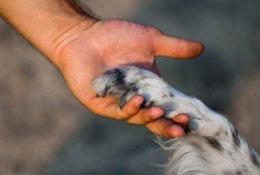
Mitchell Veterinary Services recommends starting your cat and dog nail trims early! Train your puppy to enjoy paw handling and nail trims through short sessions of positive reinforcement. It is never too early to start trimming a kitten’s claws to accustom them to nail trimmers. This is a bonding opportunity for you and your pet. Reserve some extra special treats for this occasion.
Dog Nails
On average, dogs’ nails need to be trimmed every 6 to 8 weeks. If the nails are left untrimmed and the dog does not keep them short by chewing or natural wear on rough surfaces (like concrete), then the blood vessel or quick becomes long. Long quicks can make future trimming difficult. Nails that are kept too long can impact the way a dog walks and can especially cause problems for an overweight or elderly dog with arthritis, as it shifts its posture into an irregular position.
Long nails are also at greater risk for getting caught on stairs or on carpet, resulting in cracks and tears. If your pet tears a nail, it is painful and often bleeds. If the bleeding continues beyond one minute, apply pressure with a clean bandage or cloth for 5 minutes. Often your pet will lick the sore toe, resulting in further pain and a bacterial infection. This requires a veterinary visit to treat with pain medication, antibiotics and bandaging.
Cat Nails
Scratching is a normal behaviour for our feline friends in order for them to mark their territory as familiar and to condition their claws. It is not realistic to expect a cat to stop this natural behaviour, but they can be encouraged to use appropriate spots to scratch. Cats are very texture-based with their scratching material selection; some prefer wood, others prefer carpet, rough upholstery with a vertical drag, or cardboard. It is important to offer your cat a scratching post in its favourite material. In the short term, aluminum foil or spray antiperspirant can be placed on furniture to prevent scratching and catnip can be used to attract the cat to a scratching post.
Trimming claws routinely can prevent extensive damage to the household, scratches to skin and the nail overgrowing into the cat’s foot pad. Always use praise, petting and treats to reward a cat for using its scratching post.
If you have questions about how to safely trim your pets’s nails or have concerns about your cat scratching in the wrong spot, please don’t hesitate to speak with our Registered Veterinary Technicians at Mitchell Veterinary Services.

